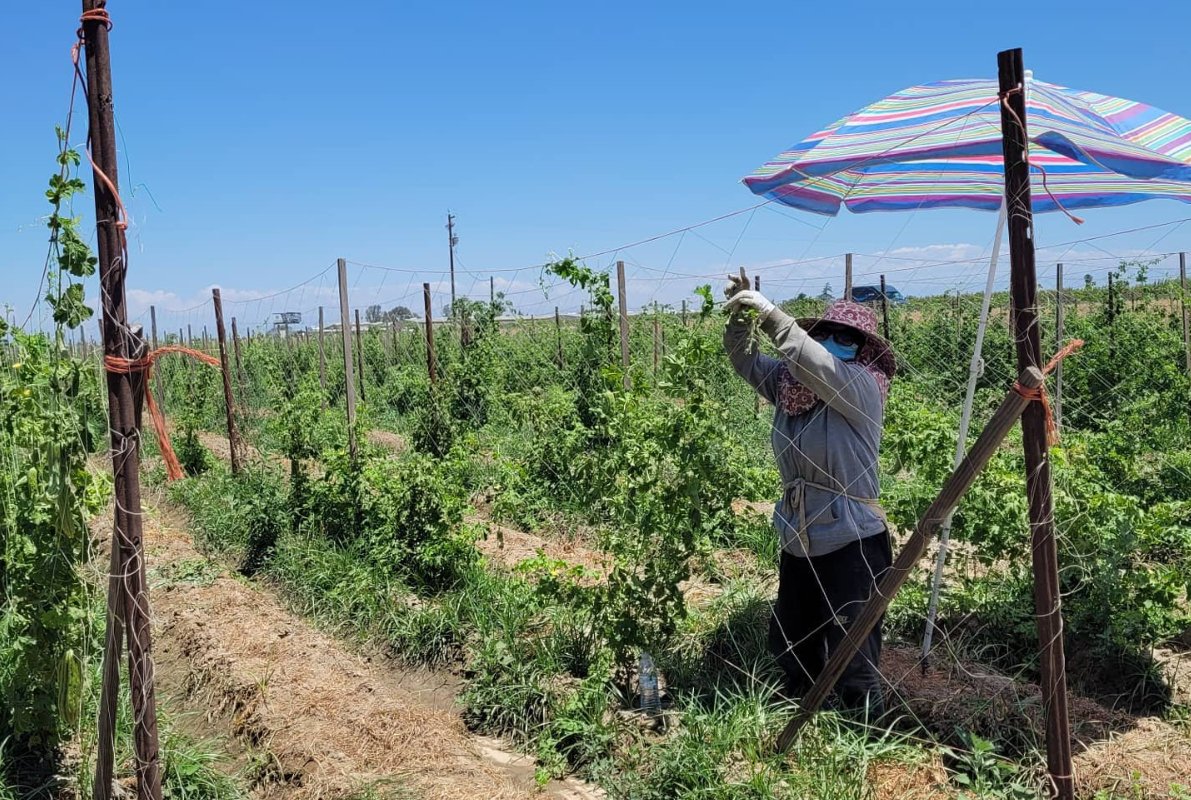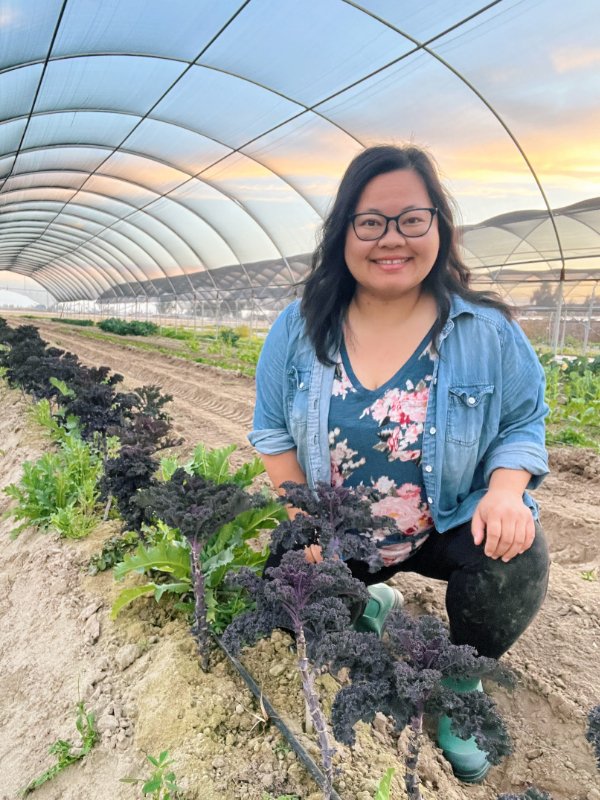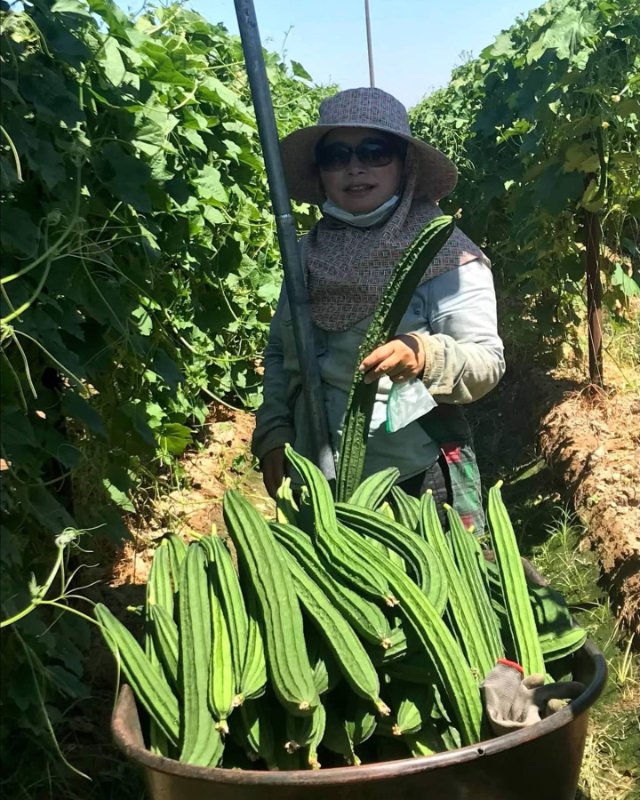Can the state’s vaunted regenerative agriculture programs—and its fight against climate change—continue without stronger local support?

Can the state’s vaunted regenerative agriculture programs—and its fight against climate change—continue without stronger local support?
May 5, 2025

GT Florists & Herbs in Fresno County participates in two of California’s climate-smart agricultural programs, and considers them “a lifeline.” (Photo courtesy of GT Florists & Herbs)
The first part of this article originally appeared in The Deep Dish, our members-only newsletter. Become a member today and get the next issue directly in your inbox.
Expand your understanding of food systems as a Civil Eats member. Enjoy unlimited access to our groundbreaking reporting, engage with experts, and connect with a community of changemakers.
Already a member?
Login
In 2019, as California’s historic drought hit its peak, the well on Lilian Thaoxaochay’s 20-acre family farm, GT Florists and Herbs in Fresno County, looked close to drying up. With rows of Armenian cucumbers, budding dahlias, and blooming jujube trees at risk, the only fix, it seemed, was to dig the well deeper—at a cost of $20,000. “It almost tanked us,” Thaoxaochay recalls of the crisis that threatened her family’s livelihood.
Then came a reprieve: the State Water Efficiency and Enhancement Program (SWEEP), a state initiative to help farms adapt to California’s increasingly erratic climate. Using the $58,000 grant, the Thaoxaochays switched their farm from full-flood irrigation to a drip system fed through trenched water lines and monitored by moisture sensors.
As part of the upgrade, they also installed a flow meter to help comply with California’s Sustainable Groundwater Management Act (SGMA), which requires farms to track groundwater use. The changes slashed not just water use, but also the energy costs of running the pump, leaving the farm far better equipped for the next drought—which arrived just three years later.
While California farmers aren’t immune to the fallout, the Golden State offers a level of support not found in much of the country.
The farm also secured a $23,000 grant through the state’s Healthy Soils Program (HSP), an initiative that helps growers integrate composting, cover cropping, and reduced tillage—practices that enhance soil health and increase its capacity to retain water and sequester carbon. In addition to boosting field productivity, the changes helped cut the farm’s reliance on synthetic fertilizers.
“It was the lifeline we needed,” says Thaoxaochay of the two programs. “We’ve been completely resilient since,” she adds, unlike many small farms that have been forced to seek emergency state relief due to erratic weather conditions.
In recent months, U.S. farmers have watched climate-related support wobble under political pressure. The Trump administration froze more than $1 billion in USDA funding for programs aimed at climate resilience and social equity, then reissued several with political strings including scrubbing references to climate change and DEI (diversity, equity, and inclusion).
A federal judge has since ordered reinstatement of the funds, but the episode has only deepened the fragility of national climate policy, casting a long shadow over efforts to help farmers brace for a future of worsening droughts, floods, and wildfires.
While California farmers aren’t immune to the fallout, the Golden State offers a level of support not found in much of the country. In addition to SWEEP and HSP, the California Department of Food and Agriculture (CDFA) oversees a suite of several climate-smart agricultural programs that cut emissions and build on-farm resilience.
These include the Alternative Manure Management Program, which funds systems that dry manure into compost rather than flushing it into methane-emitting lagoons; the Biologically Integrated Farming Systems Program, to promote low-input, plant-based farming methods; and the Sustainable Agricultural Lands Conservation Program (SALCP), to fund conservation easements that permanently protect farmland, preserving them as carbon sinks. (See “California’s Climate-Smart Farming Programs,” below, for details.)

Lilian Thaoxaochay said a recent drought “almost tanked” her family’s farm. A California initiative, funded by the state’s Cap-and-Trade program, helped them switch to a drip system. (Photo courtesy of GT Florists & Herbs)
All these initiatives are funded through California’s Cap-and-Trade Program, which channels billions of dollars towards reducing greenhouse gas emissions and spurring economic growth.
Enacted in 2006 and implemented in 2013, Cap-and-Trade requires major polluters like oil refineries and manufacturing facilities to buy “allowances” at quarterly auctions to offset their carbon output. The proceeds flow into the Greenhouse Gas Reduction Fund (GGRF), which pays for the state’s climate-smart agricultural programs—along with more than 80 other climate initiatives across transportation, housing, and energy. Together, these investments support California’s goal of achieving net-zero emissions by 2045, positioning California as a national model for integrated, climate-resilient policy.
Eleven Northeastern states also cap power-sector emissions through the Regional Greenhouse Gas Initiative. Yet California Cap-and-Trade is the only program that directly accounts for emissions from agriculture, the leading global source of atmospheric methane and responsible for 8 percent of California’s carbon emissions.
Despite these significant emissions, the climate-smart agricultural programs designed to reduce them receive just 5 percent of Greenhouse Gas Reduction Fund (GGRF) allocations. That imbalance, says Brian Shobe, policy director at the California Climate & Agriculture Network (CalCAN), overlooks agriculture’s outsized potential to sequester carbon and build climate resistance: Healthy fields, pastures, and orchards enhance biodiversity, improve water retention, and help buffer farms against extreme weather.
With federal funding cuts hitting California’s farmers—and Trump’s recent executive order seeking to nullify state cap-and-trade systems—advocates are pushing for more than just a renewal of Cap-and-Trade’s existing allocations. As the program moves toward reauthorization in 2030, a coalition of agricultural and environmental groups, including CalCAN, has started urging lawmakers to lock in 15 percent of GGRF revenues for agricultural climate programs.
And, in mid April, Governor Gavin Newsom, Senate President pro Tempore Mike McGuire, and Assembly Speaker Robert Rivas pledged to extend the program, framing it as a chance to “demonstrate real climate leadership” on the national stage.
Stable funding, says Shobe, would let more farms and ranches adopt long-term climate solutions instead of scrambling for inconsistent, one-off grants tied to fluctuating auction revenues. It would also fortify the state’s broader climate strategy, he adds, and help stabilize the food system against climate-driven shocks that drive up grocery prices.
But agriculture isn’t the only sector competing for those funds. With no automatic appropriations for most climate programs, about 40 percent of Cap-and-Trade revenue is up for grabs each year, prompting fierce competition among advocates for housing, transit, energy, and agriculture.
“There’s an annual food fight over limited climate dollars,” says Zack Deutsch-Gross, policy director at Transform, a nonprofit focused on sustainable, equitable transit and land use. “It pits climate advocates against one another as they seek [stable] appropriations for their programs.”
CalCAN and its allies argue that carving out 15 percent for agricultural programs is essential to safeguarding California’s food supply in the face of relentless cycle of droughts, floods, wildfire, and heatwaves.
“This is a once-in-a-decade opportunity to secure a more stable, climate-resilient food system,” Shobe says. Given the competition for funding as Cap-and-Trade’s reauthorization deadline nears, and the added pressure of federal pullback, he and his colleagues are wasting no time in laying the groundwork for legislative support.
Since its launch, the Cap-and-Trade Program has helped drive down California’s greenhouse gas emissions, with year-on-year reductions across the board. The market-based approach has spurred innovation in clean technologies and generated more than $25 billion in climate investments while boosting the state economy. Those funds support programs in agriculture, renewable energy, wildfire prevention, and air quality improvements, and amplify their reach. Though the program is authorized through 2030, reauthorization will require a two-thirds majority and substantial legislative maneuvering, which has already begun.
Last month, Assemblymember Jacqui Irwin, chair of the Joint Legislative Committee on Climate Change Policies, introduced a bill to extend Cap-and-Trade beyond its expiration date. While Irwin did not respond to Civil Eats’ requests for comment on the bill or its implications for agricultural funding, the move signals growing legislative recognition of the program’s role in backing climate initiatives, including those that support farmers.

Gianina Thaoxaochay harvests sigua, a luffa gourd, at GT Florists & Herbs. (Photo courtesy of GT Florists & Herbs)
Agricultural programs, meanwhile, remain among the state’s most cost-effective climate investments, says Shobe, measured by the cost per ton of greenhouse gas reductions. That includes initiatives focused on water efficiency and soil health, along with the CDFA’s Cap-and-Trade-funded climate-smart programs.
Despite their impact, most of these programs face inconsistent, boom-and-bust funding. SALCP is the only one with continuous appropriation, receiving 2 percent of GGRF revenues through the broader Affordable Housing and Sustainable Communities Program. Yet even with that modest share, it accounts for 15 percent of all GGRF emissions reductions.
“These programs offer cost-effective, scalable solutions—especially for small- and mid-sized farms—to help them adapt to worsening climate extremes,” says Shobe. Yet their reach remains limited due to volatile funding. Without sustained investment, many farmers face steep barriers to adopting climate-smart practices at the scale needed in a sector already operating on razor-thin margins.
And it’s not just farms feeling the squeeze, Shobe says—consumers are, too. As human-induced climate change continues to disrupt food production, raise grocery prices, and worsen inflation, the economic strain will intensify, he adds, without greater investment in farm resilience.
“Families feel climate change at the checkout line,” Shobe says. “If we don’t invest now in protecting our food system, we’re going to see real cost impacts.”
As a fifth-generation dairy farmer, Paul Danbom, owner of Brindeiro & Danbom Dairy Farms in Stanislaus County, has had to adapt to erratic weather and an ever-shifting economic landscape. His operation includes 900 milking cows, a small beef herd, and 500 acres of corn and almonds spread across the vast, sunbaked expanse of California’s Central Valley. Yet even with diversification, soaring fertilizer costs have whittled away his slim margins.
In 2022, Danbom received a $565,000 Alternative Manure Management Program (AMMP) grant, which funded roughly three-quarters of a system that captures manure before it’s flushed into methane-emitting lagoons, then dries it into nutrient-rich compost. According to a CalCAN report, AMMP projects have cut methane emissions by the equivalent of removing nearly 150,000 cars off the road annually.
“This is a once-in-a-decade opportunity to secure a more stable, climate-resilient food system.”
“We’re now producing about 80 percent of our fertilizer needs on-farm,” Danbom says. The compost improves soil structure, reduces pesticide use, and, once aerated, serves as soft cow bedding. “It’s totally increased my [waste] management efficiency,” he says, “and helped my bottom line.”
Despite those gains, anaerobic digesters—larger-scale systems that capture methane from manure lagoons and convert it into biogas for fuel—dominate manure management funding. Through a combination of GGRF and other programs, California has committed nearly $677 million to these dairy digesters while the Biden administration made parallel investments through projects such as the USDA Rural Energy for America Program.
Collectively, manure management projects have slashed methane emissions from California’s dairy sector by 22 percent, according to research. Yet digesters continue to receive the bulk of public funding, with supporters maintaining that they deliver the biggest methane cuts in the livestock sector and are key to hitting state climate goals. Critics, though, counter that this focus overwhelmingly favors large-scale operations, effectively incentivizing the growth of mega-dairies and potentially boosting emissions.
“We need all of the programs working together,” says Michael Boccadoro, executive director of Agricultural Energy Consumers Association. “Farmers of all sizes need solutions that work for them.” His coalition is pushing for a $75 million annual allocation for small- and large-scale manure management approaches, alongside increased funding for farming infrastructure and processing upgrades. Nevertheless, he maintains that dairy digesters provide the best return on investment, noting that they can capture up to 90 percent of methane emissions from livestock waste.
Still, digesters only make financial sense at a certain scale, making dry manure management a better fit for smaller dairies—if they can access funding. AMMP, along with healthy soil and water efficiency programs, are often the most accessible options for small-scale farms facing financial and logistical barriers. But they’re oversubscribed, Danbom says—he applied three times before securing his grant. Without consistent support, he warns, the climate-smart solutions “consumers increasingly demand” may be out of reach for the farms best positioned to implement them.
Meanwhile, other sectors are also calling for more reliable Cap-and-Trade support. Transportation, housing, and energy advocates are urging lawmakers to close structural gaps in the program. Deutsch-Grosse of Transform points to two key loopholes: free pollution allowances—permits granted to industries such as oil and manufacturing to encourage them to stay in-state—and carbon offsets, which let companies meet emissions targets by funding reductions elsewhere rather than cutting their own. These mechanisms “facilitate continued pollution in frontline communities,” he says, and reforming them could boost GGRF revenue while advancing environmental justice.
As the outlook for national climate policy darkens, that push has gained urgency, says Adina Levin of Seamless Bay Area, a transit equity and land use advocate. Her group, along with Transform, is part of a coalition pushing the state to direct Cap-and-Trade dollars towards affordable housing and public transit—investments that reduce emissions, improve air quality, and benefit frontline communities rather than subsidize high-polluting sectors such as industrial agriculture.
With transportation as California’s largest source of greenhouse gases—and a major contributor to particulate pollution—Levin sees transit and transit-oriented housing as essential infrastructure. And like climate-smart agriculture, these programs deliver broad, lasting returns, she says, by expanding low-cost housing, boosting transit ridership, and easing public health risks linked to air pollution.
“Without consistent funding, we’re left crossing our fingers that these programs will still be around after each funding cycle—rather than building on their success.”
“Since federal funding is likely to be unreliable in the near term, it’s essential for California to stand up for equity and climate action,” Levin says. Keeping up that momentum matters: California’s climate initiatives have become a national model, from inspiring Healthy Soils programs in eight states including New Mexico and Montana, to shaping affordable housing and transit policy in the Pacific Northwest.
And ultimately, sustaining this leadership hinges on stable funding.
On the dry, chaparral-covered hills of California’s Central Coast, shepherd Jack Anderson runs Cuyama Lamb, grazing 1,200 sheep for wildfire prevention as well as for food and wool. His flock also cycles through vineyards and ranches supported by Healthy Soils grants. Here they graze cover crops and control brush while enriching the soil, sequestering carbon, and helping to control erosion.
Despite the layered benefits, Anderson often sees regenerative practices “stymied by the inconsistency in funding.” Having witnessed eager landowners walk away from projects when support fell through, he adds that “it really slows the adoption of something that not only meets our climate goals, but stabilizes our food system in the face of climate change.”
Thaoxaochay, of GT Florists and Herbs, agrees. As a University of California Cooperative Extension agent who works closely with small-scale farmers, she’s seen firsthand how transformative these programs can be. And she notes that once farmers adopt these techniques, they tend to stick: Research shows that 75 percent of grant recipients continue the practices well after funding ends.
“The long-term impacts . . . are greater than we could ever imagine,” Thaoxaochay says. “But without consistent funding, we’re left crossing our fingers that these programs will still be around after each funding cycle—rather than building on their success.”
This article was updated to include the correct spelling of Zack Deutsch-Gross’ last name.

July 30, 2025
From Oklahoma to D.C., a food activist works to ensure that communities can protect their food systems and their future.
Leave a Comment